One of VW’s chief calling cards has always been efficiency. 
For a long time – until very recently, in fact – VW was the only car company selling affordable diesel-powered cars. The handful of others were all high-end luxury brands (Mercedes, BMW, Audi).
Now VW is striving to make its gas-powered offerings more efficient, too.
The 2014 Passat, for instance, can now be ordered with a new 1.8 liter turbo four, which over the next few months will be phased in as the Passat’s main vein gas engine – with the performance-minded 3.6 liter VR6 still available as an option, along with the superb 2.0 turbodiesel (TDI) four.
The 2.5 liter in-line five – up to now the Passat’s standard gas engine – will be gradually retired. Not because it’s a bad engine. It’s just too thirsty – and too slow pokey – an engine.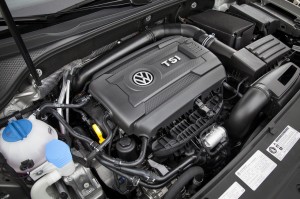
The new direct-injected 1.8 turbo is a two-fer: Better mileage and better performance. But the best part is there’s only about a $50 price increase to get it, too.
I’ll clap to that.
WHAT IT IS
The Passat is VW’s largest sedan – built specifically for the U.S. market (and made here in the U.S., too – in TN). It is a bit larger outside – and roomier on the inside – than several Japanese competitors, including the Toyota Camry and Honda Accord – and is unique in being the only largish sedan in its segment that can be ordered with a diesel engine.
Prices start at $20,845 for the base S model with 2.5 liter five-cylinder gas engine- which will still be offered for the first few months of 2014. However, you can upgrade to the new, more powerful (and fuel-sippy) 1.8 liter turbo four for just $50 more – $20,895.
Sport and SEL trims now come standard with the 1.8 liter engine.
The performance-themed VR6 will remain available – as will the TDI diesel version.
WHAT’S NEW
The big news is the new 1.8 liter turbo’d (and direct injected) TSI four cylinder engine, which delivers the same 170 hp as the fading-away 2.5 liter non-turbo five – but more torque much lower down (184 ft.-lbs. at 1,500 RPM vs. 177 ft. lbs. at 4,250 RPM) and, as a result, significantly improved fuel economy and performance.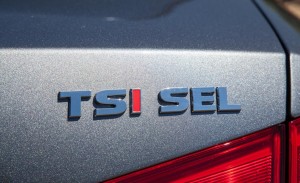
All but base S trims now come with a standard rearview back-up camera and VW’s Car-Net telematics system is optional in the higher trims. The audiophile Fender music system – tuned to the acoustics of the car’s interior – continues to be available as an option as well. This package also includes interior enhancement based on the appearance of Fender guitars.
WHAT’S GOOD
Audi-esque feel/fit/finish and handling . . . VW price tag.
Available diesel engine – and 43-plus MPG on the highway.
New 1.8 liter gas engine delivers 34 on the highway and 0-60 in 7.6 seconds (vs. 9 with the old 2.5 liter five).
Manual transmission available with all Passat engines except VR6.
Roomier inside (especially in back) than most of the competition.
U.S. buyers won’t get 50 MPG-capable Euro-market 1.6 liter TDI diesel engine.
U.S. buyers can’t get the wagon version of the Passat (also Euro-only) and AWD is no longer offered . . .
here.
UNDER THE HOOD
The Passat’s standard 2.5 liter engine is unusual – unique in this class – because it’s not a four cylinder engine, unlike the standard engines in every other car in this segment. It’s a five-cylinder – and makes 170 hp and 177 lbs.-ft. of torque. However, despite its additional piston, the 2.5 liter five’s power/torque output isn’t better than several competitors’ smaller displacement fours – and in some cases, it’s less. The Honda Accord’s standard 2.4 liter four, for example, makes 185 hp – and 181 ft.-lbs. of torque.
The Nissan Altima’s 2.5 liter four makes 182 hp and 180 ft.-lbs. The base Camry four produces 178 hp.
The Five is also not very economical – 22 city, 32 highway with the manual transaxle. With the optional six-speed automatic, the highway number drops to 31. This would be palatable if acceleration were standout – and it is, but in the wrong way. The 2.5 equipped Passat take about 9 seconds to get to 60 with the automatic, doggy performance for a subcompact economy car and unacceptably sluggish for a car in the Passat’s class.
Manual versions are only slightly quicker.
Enter the new 1.8 turbo TSI engine. Due chiefly to its instant-on torque (peak arrives 3,000 RPM sooner than the 2.5 liter’s max effort) the car accelerates much more acceptably: Zero to 60 in 7.6-7.7 seconds (depending on the transmission; both manual and automatic gearboxes are available). This is more than a full second quicker than the 2.5 liter Passat and – here’s the bonus – gas mileage is better, too: 24 city, 34 highway with either transmission. These figures put the Passat right in the thick of things again – instead of way back there somewhere.
And of course, you can put some real distance between yourself, the competition – and gas stations – if you choose the available 2.0 TDI diesel. It delivers an untouchable (in this segment) 31 city, 43 highway. I’ve driven this version of the Passat extensively and can report that – for once – the advertised/EPA mileage figures are below what the car is realistically capable of. I’ve seen 45-47 MPG on the highway. This is exceptional. Only a few hybrids do better – and not by much. Moreover, the diesel will probably last longer – and cost you less to maintain. The TDI Passat also performs – courtesy of the tremendous torque output of the diesel engine (236 lbs.-ft., produced just over idle speed). It pulls hard off the line – and has excellent passing power.
If more performance is wanted, VW still offers the 280 hp 3.6 liter V-6. So equipped, the Passat is capable of reaching 60 in about 6.3 seconds. That’s about half a second quicker than the top-of-the-line Ford Fusion equipped with its turbo 2.0 engine (240 hp) and just a tick behind the quickest car in this class, the V-6 powered Accord (278 hp) which gets to 60 in 6.1 seconds.
Unfortunately, the Passat’s V-6 is not offered with a manual transmission – just the DSG six-speed automated manual. Probably because of fuel efficiency pressures. With the very efficient DSG automatic, the 3.6 liter engine manages a not-bad 20 city, 28 highway. With a manual, this number might have been lower – and in these CAFE conscious days, even a nominal 2-3 MPG difference can spell The End for a manual transmission (or for that matter, a five-cylinder engine).
For example, while the automatic-equipped V-6 Accord gets 21 city, 34 highway, the same engine with a manual transmission (in the Accord coupe) drops to 18 city, 28 highway.
VW – like everyone else – has to sweat the MPGs. Not so much because buyers are demanding fractional improvements but because the government requires it. Two model years from now – 2016 – any car that doesn’t average 35.5 MPG will come with “gas guzzler” fines tacked on to its MSRP.
While it used to be true that a manual offered an efficiency advantage vs. an automatic, today, the reverse is often true. Modern automatics – especially CVT and DSG-types – are frequently more economical than manual transmissions.
That’s why most car companies are going over to automatics – and in more and more cases, dropping manuals from the roster entirely.
We should be grateful that VW still offers manual transmissions at all – and ecstatic that they’re available with three of the four available Passat engines.
ON THE ROAD
The Passat’s personality range is wider than most of its rivals – because most cars in this class only offer two engine options – the “economy” engine and the “performance” engine. There’s not much in the middle. With Passat, you can go with the base 2.5 engine, the new 1.8 turbo TSI gas engine, the VR6 – or the TDI diesel.
That’s a lot of options – and a wide variety of personalities.
The Ford Fusion is one of the Passat’s few rivals that offers three engine options, but the base- engined version (being sold only with an automatic) is about as much fun as leftover hospital food. It gets the job done – nothing extra. And the Fusion – like every other car in this segment – simply hasn’t got anything in its roster that can compare with the TDI -equipped Passat’s exceptional economy, fun-to-drive character and probable service life of 300k-plus with decent treatment (being a diesel).
Though not a threat to Corvettes, you can have a lot of fun with that TDI – which can do a pretty impressive front-wheel-drive burnout, if you want it to. The V-6 Passat, on the other hand, would be more appealing if you could shift for yourself. Granted, pretty much all of the Passat VR6’s competition is also automatic-only but that’s all the more reason for VW to offer a manual with the V-6. With the DSG, the Passat sometimes feels sluggish – there’s a slight but noticeable lag in between what your right foot inputs and when the transmission responds. As far as the base 2.5 engine, it’s a milder-mannered counterpoint to the peaky power of the smaller/higher-strung fours in the competition. Teamed up with the standard manual transmission, it also makes the Passat fun to drive, despite being slower than the competition.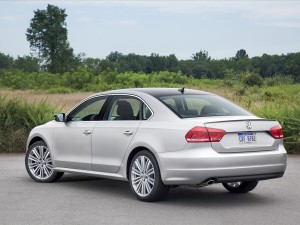 A manual-equipped car is always the more engaging/involving car.
A manual-equipped car is always the more engaging/involving car.
The new 1.8 liter engine, though, may be the pick of the litter.
It may not be quite as efficient as the TDI, but it’s not all that far off. And it costs several thousand dollars less to buy – which means the break-even point for the TDI is at least several years of driving down the road. The 1.8 engine also outclasses the outgoing 2.5 liter engine in every way – and given the small additional cost of acquisition, it’s hard to imagine anyone choosing to stick with the old five over this new four.
Handling is tight, precise – very German car. Though some critics point out that the U.S.-spec Passat is bigger, heavier (and yes, softer) than the Euro-spec./previous generation Passat, it is still a very neutral-handling, responsive car that will not disappoint drivers who enjoy a more rapid pace. 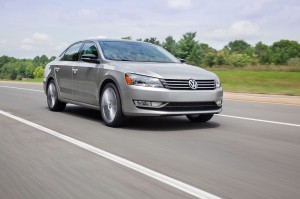
It’s just a crying shame American buyers can’t get either the wagon – or the AWD system. These are for European buyers only.
But – light at the end of the tunnel – the Alltrack wagon is on deck for 2015. Though not technically a Passat – it’s based on the Passat, it’s bigger than the Jetta, it will offer AWD and the new 1.8 engine, too.
AT THE CURB
This is a handsome, nicely put together car.
Park the Passat next to an Audi A4 or A6 and you’ll see the kinship in form. Same goes for the interior, which is a cut above others in this price range in terms of feel, fit and finish. It’s almost-Audi, which should not be surprising given the corporate cross-pollination.
It’s almost-Audi, which should not be surprising given the corporate cross-pollination.
Another aspect of the Passat’s perennial appeal is its conservatively evolving styling – which keeps older models looking current longer and will probably do the same for this model, too.
But, the big news about the current Passat is that it’s a bigger-than-ever Passat: 191.6 inches long overall vs. 188.2 for the previous gen. Passat – and rides on almost four inches more wheelbase (110.4 inches vs. 106.7). This was all done to carve out more interior room, to make the German-brand Passat a bit more appealing to American buyer preferences.
How much more room inside is there?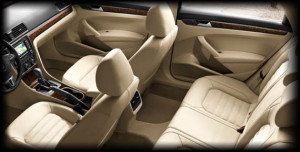
How about an inch more front seat legroom (42.4 inches vs. 41.4) and 1.4 inches more second row legroom (39.1 inches vs. 37.7 inches)?
Ok, that’s not earth-shakingly different. Here’s one stat that is: The 2014 Passat has 2.4 inches more shoulder room in back (and 1.2 more up front) than the previous gen. Passat – a difference in dimension that’s immediately apparent if you sit in the old car and then sit in the new one. VW adds to the effect by cleverly scalloping out the inner door panels, leaving you both the impression and the actuality of more elbow room.
The trunk is slightly larger now, too: 15.9 cubic feet vs. 14.2 before.
Not only is the new Passat bigger than the previous Passat, it is slightly larger than most of the cars it competes with, whereas previously it was slightly smaller.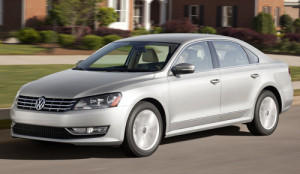
The current Passat has more front and and rear legroom (42.4 inches and 39.1 inches, respectively) than the best-selling Camry (41.6 inches and 38.9 inches) whereas the old Passat was noticeably tighter fitting relative to cars like the Camry – especially in the back seat.
Some fault VW for up-sizing the Passat but it makes sense from a business point-of-view. Though the previous Passat was more like the VWs in Europe, where smaller is often regarded as better, the fact is this is America – and different rules apply.
People here are larger – and larger people want larger cars.
In any case, the current Passat no longer has to make excuses for being a bit smaller outside – and a tighter fit on the inside – than the others in this segment.
It’s frankly hard to find much to criticize about this car. The Passat costs less to start than pretty much any other car in this segment, it’s got more engine/transmission options, it is wonderfully roomy and comfortable, drives beautifully.
Good looking, too.
Excellent seat heaters; the Fender audio package rocks.
I would like to see VW offer a “value package” TDI Passat equipped with just the TDI engine, the manual transmission and a handful of necessary basic equipment like AC – and all the rest available but optional. This way, VW could offer the superb TDI engine and the superb fuel economy it delivers at a much more economical price. Maybe $23k or so – vs. the current $26k – which would give the competition conniption fits but put a smile on the face of many a buyer.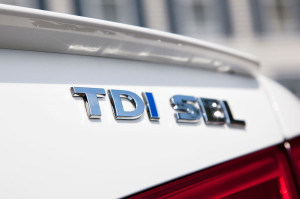
This, by the way, is how diesel-powered cars are generally sold in Europe. Basic – as opposed to loaded. Here, they’re sold as higher-trim/higher-priced models, typically loaded up with cost-adding luxury features that are certainly nice to have but which also eat away at the primary reason for buying a diesel-powered car.
You know – to save money.
I’d also like VW to re-locate the controls for the outside rearview mirrors to a less awkward-to-get-at place. Right now, they’re positioned at an unnatural angle (for the human wrist) on the door panel – because the current shape of the arm rest doesn’t leave much room for the controls. Also, the little toggle button seemed fragile to me – and likely to break off at some point down the road.
But these are small things – literally.
I had to come up with something.
The new 1.8 liter engine corrects the only serious criticism one could level at last year’s Passat – that in gas-engined guise, it wasn’t very fuel efficient relative to the competition – and was too slow (in base engined form) relative to the competition.
Now about that TDI wagon . . .
Throw it in the Woods?
PS: Please consider supporting EPautos.com. We got dumped by Google – see here for the full story about that – and now we depend on you, the readers, to keep the lights on and the wheels spinning.
The link to our “donate” button is here. You can also mail stuff our way – if you prefer to avoid PayPal. The address is:
EPAutos
721 Hummingbird Lane, SE
Copper Hill, VA 2407


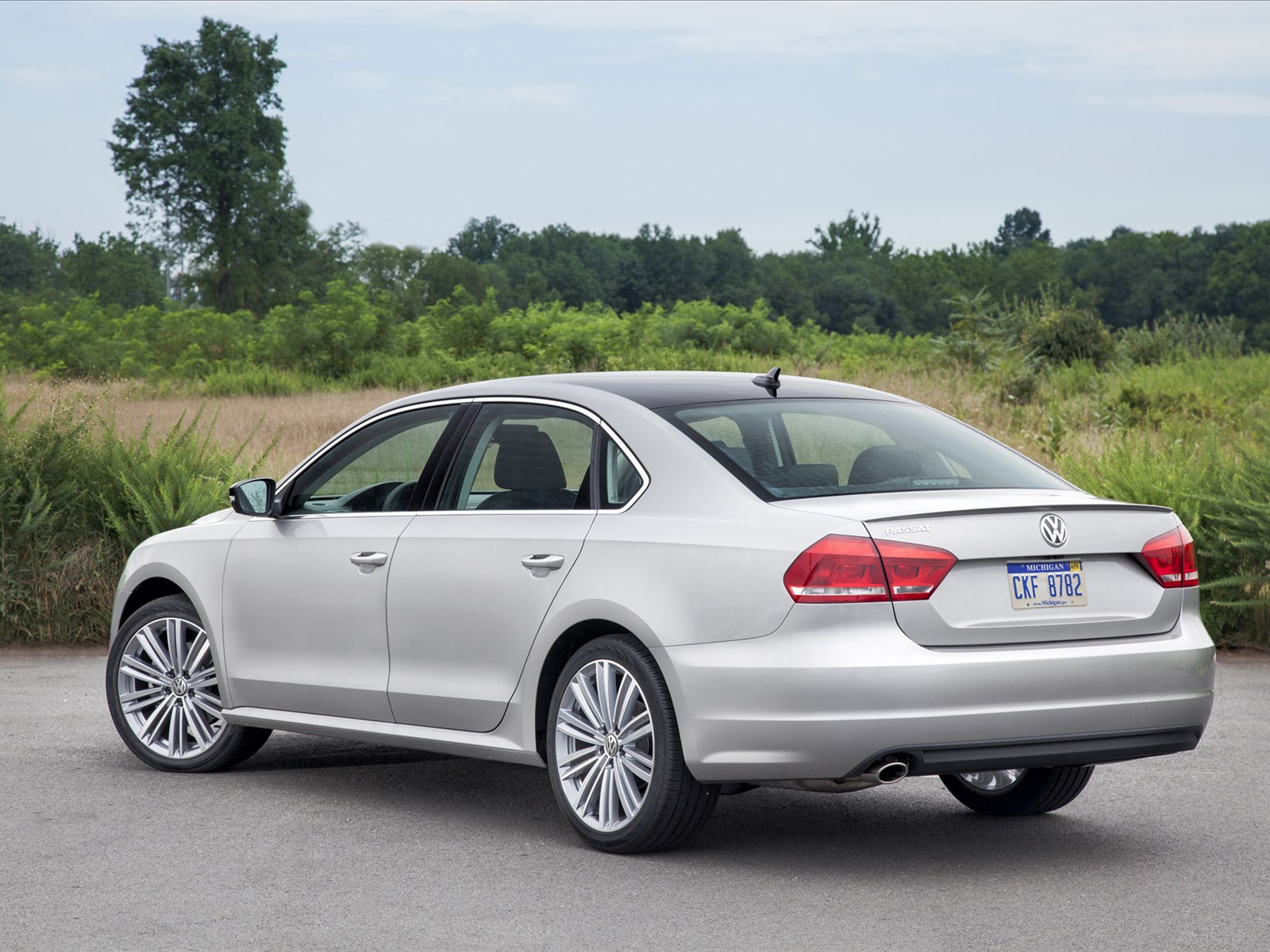










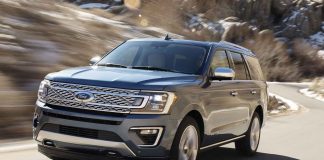
Thanks for this great review, Eric… six years later! It’s just what I was wanting to know about these cars. I’m looking at buying a 2014 Passat TDI SEL Premium with 75k miles on the clock for $10k tomorrow after a 24-hour extended test drive. These are April 2020 Lock Down Days but the dealership insists they are an Essential Business and I agree.
I’m a confirmed end-user, not a true gear head, but this car seems solid to me. Nothing leaking in the driveway after driving it a little. A/C and all the gee-gaws on this SEL seem to work. Leather and seat bolsters are in good shape. Engine makes a little more diesel sound effects than a gas car, but I think that’s normal. This car takes Ultra Low Sulfur Diesel and has a DEF tank fill-up hidden in the trunk. Pretty sure it needs the DEF tank to be topped off every so often. Any thoughts?
Low end torque and acceleration is wow! I chirped the tires pulling out of my driveway this afternoon after punching it. Got to 65 in a few seconds.
Is there anything I need to be concerned about with these six-year-old Passat TDI’s before buying one? I really like it.
Thanks for all that you do to preach and teach liberty.
Happy to, Jetta – and thanks for the kind words!
I’m hoping we can get back to talking cars – not Corona – soon!
I am so happy they brought back the 1.8 turbo. This is an amazing engine. I had one in my 2004 Passat and loved it. It also has a large aftermarket for tuning. I have heard tale of 300 hp being pulled out of this engine by performance tuners. It handles heat exceptionally well, and could run my Passat at 134 mph across a desert highway all day long in 120 degrees.
That being said. Do you know if they have moved to a timing chain or does the 1.8turbo still use a belt? The belt needs to be replaced at 80,000 miles, it costs about $1,500 to do it, and if the belt breaks, the engine is toast.
Am I going senile? I could have sworn I was on this string a day or 2 ago and there was discussion about issues with the oil plug – needing a new washer each time or some such. I’m getting lazy as I age, and have not changed the oil on the 09 Sportwagen myself, but want to keep up on info like that in case the time comes where it’s not an option.
Someone posted, claiming that the oil plug – not the copper gasket – needed to be replaced at each oil change. I’ve never heard of anything like this, but anything is possible. Still, I suspect the poster either misspoke or is misinformed. Every automotive drain plug I’ve ever seen is a threaded metal plug, basically – a bolt. They often have a crush gasket to eliminate/reduce seepage and assure a positive seal. But I can’t see how the plug itself could “go bad” unless someone ruined the threads or otherwise physically damage it.
Been there, done that, on my first car, a 1960 Fairlane. But it wasn’t the plug that failed, it was the threads in the pan. Some fun!
Found that string – it’s on “New Cars are (sometimes) Easier to Maintain.”
Why will a diesel last longer than a hybrid, and cost less to maintain? (Especially given this is a VW… urea requirements?)
I predict the diesel vs hybrid debate will become bigger and bigger as time goes on.
I agree with swamp, having it built in the USA is a merit I’m fond of.
You have to take off the front bumper to get to the oil filter of the 98-05 passat. I know in your other video you showed how easy it was to get to in this one. Do you think newer VWs are not going to be costly nightmares to service, compared to older ones?
Thanks, good review.
Hi Brandon,
As far as durability/longevity: Diesels use compression and heat (rather than spark) to initiate combustion. They – generally – have very high compressions ratios relative to a gas/spark-ignition engine. This places much higher loads on internal parts, which in turn necessitates stronger engine blocks, connecting rods – and so on. Also, diesel fuel acts as a lubricant – unlike gas, which acts as a solvent. Gasoline washes away the protective film of oil on metal surfaces; this problem is not an issue with diesel engines.
As far as maintenance: Diesels have fewer common replacement parts – spark plugs being the obvious example. And relative to hybrids, which have both an engine (gas burning) and an electric motor and a battery pack, there is less to go wrong. The hybrid’s gas engine is similar to other gas engines in that its useful service life is going to be about the same as any other gas engine. But the diesel – per the earlier points I mentioned – ought to last several hundred thousand miles, if not abused. No worries about the eventual, inevitable need to replace the battery pack, either.
I know VW has had some issues in the past, but their diesel engines have a good reputation. As to the new 1.8L gas engine – I can’t honestly say (either way). No one really can, as these cars (and engines) haven’t been in circulation in the real world long enough to have data to reference.
But I can say VW has made an effort to make the 1.8L DIY-friendly. The oil filter, for instance, is literally “right there” and all you’d need to remove/replace it is a crescent wrench (or socket to fit the nut on top of the housing). It’s not obscured by anything, no need to remove anything to get at it.
I wasn’t able to get underneath the car – it snowed yesterday and it’s like 8 degrees outside – but I assume the oil drain plug is just as accessible. That means changing oil is a breeze. Other examples:
The serpentine belt tensioner pulley is hand accessible – so it should be pretty simple to swap out the belt when the need arises. The alternator is mounted in a visible/accessible place….
I’m sure there are things that are not easy – this is true of every car I have ever worked on. But they definitely made some routine jobs easier – and I tip my hat to them for that!
The 2.0 Liter TDI engine doesn’t require urea injection. It uses a catalytic converter that can burn up soot enough to meet the EPA requirements. It’s the only engine VW has that can do this, which is why we don’t get the 1.8(?) L inline 4 that goes into quattro Audis in Europe (quattro engines and transmissions are mounted longitudinal, and the 2.0 L engine is too big for that).
Disel engines are cast iron/steel because they have to withstand much higher compression and detonation pressures that an aluminum engine would never handle. They also rev much slower, instead making more torque, and they typically run cooler too (which is why you see trucks covering their radiators in winter).
About the only thing that really is a major failure point on diesels is the turbocharger, but with that becoming the norm on gas engines again, that replacement expense is negated. As long as you keep up on oil changes (or install a bypass oil system), you should get over 100K out of it too.
I don’t know about the newer Tdi engines, but the injection pumps on the Tdis are also a bit of a weak point, especially if water gets past the fuel filter. I’ve had more problems with the injection pump on mine (leaking o-ring) than the turbo (no problems so far).
Eric G – good to know about the urea in the 2.0 TDI. I was concerned I had missed something about my 2009 Sportwagen.
BTW, I have over 150k on it, and the only issues are: 1)the cruise control no longer works: 2) I have a recurring check engine light that has something to do with the EGR system. Good thing I don’t have to do emissions inspection in Maryland with the diesel.
Thank you for the education Eric and Eric. It’ll all be helpful for my family in the next few years. My dad is getting either a diesel or a hybrid for his next vehicle. At this point, I would rather him get a diesel. I’m pretty curious about them. I imagine the price of diesel/gallon will be the only thing holding him back.
Np!
Current (and recent) diesels are very appealing. In the past – roughly, about 20 years ago and earlier – passenger vehicle diesels were durable and fuel efficient, but they were also slow, noisy and smokey. Much harder to put up with than current diesels, which behave very much like gas engines in that they are quiet, do not smoke – and perform admirably, in addition to being economical. Some of them – the Audi diesel V-6, for example – produce so much torque (420 ft.-lbs., which is more than most gas V-8s) you feel like you’re getting air under the front wheels when you punch it coming off the line – just like a bracket racer!
I am becoming a big fan of VWs. Ever since I drove a Jetta way back in 2006, I have been drawn to their high speed sturdiness on the highways as well as their relative efficiency (although the 2.5L engine is less so).
It appears that the 1.8L turbo is going to be a winner. The acceleration on it is about 1 second off from the GLI and offers higher fuel mileage in a bigger car. As equipped, it runs on regular as opposed to premium.
I hope that the US market will drive aftermarket accessories for the Passat, although I seriously doubt it will.
I like the availability of the manual transmission as well. It appears that the manuals are just as fuel efficient as the DSG transmissions, which is a plus.
When I get ready to purchase a car, the VW will be on my list. It’s large, roomy and built here in the USA. I can’t help but to think that if there were a $1500 tariff on Mexican made cars, there would be a lot more choices of American built cars. In the mean time, this VW gives the driver a choice of having a car that will sustain high speed driving while delivering great gas mileage. The TDI is a great car, but diesel prices are way too high to be economical.
Ditto all that, Swamp!
This car is one of my favorites – not just in its class, but period.
If I were in the market for a medium-large sedan, it would be high on my list of prospects.
The problem with this Passat for me is, as you said, it is made specifically for the US Market meaning, it is a step down from the European Passats. On pre-US made Passats, it used to be possible to swap-out the lousy US Spec. parts for better and safer European pieces but appearantly this is no longer the case – notably the shitty mirror glass and rear lights.
By the way, the 5th picture down is of the Golf 7 Variant.
Hi Doug,
True – but it works both ways. The U.S.-spec. Passat (as mentioned in the review) has significantly more interior space, especially in the back seat. For people who regularly carry adults in the second row, that’s no small thing.
And the new 1.8 engine really is top drawer. It’s a tough call for me which is the better choice – it or the TDI. I prefer the TDI as such, but VW packages it with other equipment, in a higher trim version of the Passat, such that its mileage advantage is to a great extent negated by the several thousand dollars more you pay up front.
It’s also pretty cool that VW lets you buy a manual (or automatic) with all the available engines – except the VR6.
I do think it’d be an interesting experiment to offer the Euro-spec. 1.6 TDI here and see how it sold (or not).
I have a hunch – given the economy – that it would do very well.
Imagine better-than-hybrid efficiency, without the complexity or cost – and with (probably) more in the way of “fun to drive” characteristics….
Is that 1.6 TDI the same one they make in TN, but can’t sell here?